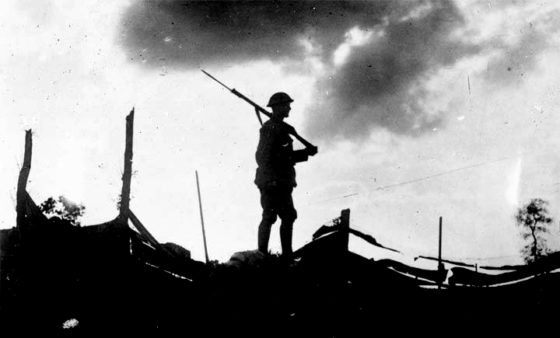
“Despite the seeming inevitability of an Allied triumph, the success of the cross-channel invasion in 1944 seemed like anything but a foregone conclusion.”
“SOLDIERS, SAILORS AND AIRMEN of the Allied Expeditionary Force! You are about to embark upon a great crusade, toward which we have striven these many months. The eyes of the world are upon you.”
General Dwight Eisenhower offered these now famous words in his address to British, American and Canadian troops in the hours leading up to the June 6, 1944 D-Day invasion.
But as the Supreme Allied Commander spoke, he carried in his pocket a slip of paper bearing a much different statement — words he hoped that he’d never have to speak.
That other speech, which Ike hastily jotted down earlier that day, was to be read if the Normandy invasion force was wiped out on the beaches and drop zones of Nazi-occupied Europe.
“Our landings in the Cherbourg-Havre area have failed to gain a satisfactory foothold and I have withdrawn the troops,” the 66-word, hand-written message began. “My decision to attack at this time and place was based on the best information available. The troops, the air, and the navy did all that bravery and devotion to duty could do. If any blame or fault attaches to the attempt it is mine alone.”
In hindsight, the success of Operation Overlord was a virtually certainty. By mid-1944, Germany’s war machine was stretched perilously thin as the Nazis found themselves on the defensive everywhere. American and British bombers were pounding the Reich around the clock and Soviet tanks were pressing in from the East. In fact, Stalin, Roosevelt and Churchill had already been meeting face-to-face to map out the shape of the post-war world.

Yet despite the seeming inevitability of an Allied triumph, the success of the cross-channel invasion seemed like anything but a foregone conclusion at the time.
Would the weather hold? Had the months of deception about to the time and location of the invasion succeeded in confusing the Germans? Would the five infantry and three airborne divisions slated for the first wave of the attack be enough to force the Allies’ way into France? No one, least of all Eisenhower, could be sure.
Ultimately the landings on Omaha, Utah, Juno, Sword and Gold beaches were successful and by D-Day plus one, the Allies had carved out solid footholds through which materiel and men would soon be pouring.
According to an article on the 60th anniversary of the invasion, Eisenhower forgot the about the note, which he folded up and tucked into his wallet shortly after composing it.
More than a month later, the general discovered the 4 x 7 inch slip of paper it and showed it to an aide before tossing it into a waste basket. The adjutant, a navy captain by the name of Harry Butcher, asked if he could keep it and Ike obliged.
Eventually, the note, which became known as the “In the Event of Failure Letter”, was added to the Dwight D. Eisenhower Presidential Library in Abilene, Kansas where it is still on display.
Oddly enough, the original draft was dated “July 5” rather than “June 5”, an error that suggests the general’s preoccupation at the moment he penned the message.
 Ike to America: That’s All, Folks!
Ike to America: That’s All, Folks!
The famous D-Day failure letter wasn’t the only bad news that Eisenhower hoped not to have to deliver in his career as a public servant.
During his eight-year presidency (1953 to 1961), the former Allied commander, recorded a series of public service announcements that were to be broadcast from the massive fallout complex at Mount Weather, Virginia in the event of an all out Soviet nuclear attack on the United States.
The messages assured Americans that despite all the devastation their government was intact and still functioning, while also providing a series of handy post-apocalyptic survival tips for listeners.
The top secret tapes featured President Eisenhower, in addition to trusted television personalities of the day like Arthur Godfrey and even newsman Edward R. Murrow. The recordings have never been released to the public, but at least one organization is calling upon the government to declassify these fascinating Cold War relics.
(Originally published on MilitaryHistoryNow.com on Aug. 28, 2013.)










Loved the details leading up to the letter not truly finding the round file! Until now, without any research or study, I just ASSUMED the note was handed to Beetle or to Kay. But in actuality and as you point out, it was really to end up in the round file until Butcher snatched it as a memento. Great stuff, sir.
Thanks for that, Mustang. Yeah, I was pretty amazed by that detail too, which is why I wanted to add it to the blog.
I’m glad you did – and many others, too. War history is so immensely interesting, isn’t it? And without crazy guys like you around, we wouldn’t know any of it. 🙂 Keep it up and educate us!
I still consider myself a layman when it comes to WWII history (being that there is just SO much to learn), so I found it very interesting that he actually wrote a letter in case of failure. Never knew this. Thanks!
Thanks for your feedback. It’s taken a few years to cobble all this content together. I hope you enjoy more of what you see.